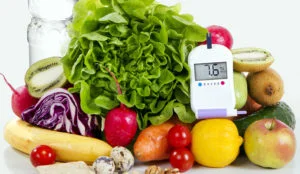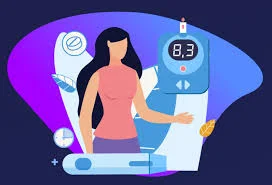Contents
What Is Normal Blood Sugar Levels Chart?
Blood sugar or glucose is released after consumption and breakdown of carbohydrates during food intake. It is the main sugar that is found in your bloodstream and its regulation is undertaken by pancreatic secretions (Insulin). Normal blood sugar levels chart for most adults ranges from 80 to 99 mg of sugar per deciliter before a meal and 80 to 140 mg per deciliter after meals.
Factors Affecting Blood Sugar Levels
- The period of food consumption
- Type of food consumed
- Exercise
- Certain medications
- Health conditions
- Age (45+)
- Mental stress
- Dehydration
- Menstrual period
- Liquor
Fasting Blood Sugar
For a diabetic or non-diabetic person, their fasting blood sugar is checked in a time frame where they have been fasting for at least 8 hours without the intake of any food substance except water. A fasting blood sugar test makes you aware of the amount of glucose present in your body.
This has proved to be a fundamental test when it comes to checking pre-diabetes or diabetes. A simple blood sample is required to carry out the test and can be done at any of the nearest diagnosis labs or even at home using a blood sugar detecting device.
As per medical sciences having a 99mg/dl is considered to be a good reading on a normal blood sugar level chart. If it goes beyond that i.e. from between 100 to 125 mg/dl, is a sign of prediabetes. However, if you have sugar levels higher than that then it is an indication of diabetes.
Non-Diabetic Blood Sugar Levels After Eating:
The normal blood sugar level for a person without diabetes is generally 140 mg/dl
Diabetic Blood Sugar Levels After Eating:
According to medical sciences, a reading of 180 mg/dl or less is considered to be normal after 2 hours of food intake in patients suffering from diabetes.
Normal Blood Sugar Levels Chart
Below mentioned are the normal blood sugar levels of fasting, before a meal, after food intake, and at bedtime in an age-wise category.
Age Group
6 years and younger
Normal blood sugar levels chart for the age group of children younger than 6 yrs old when
- Fasting is in between 80 – 180 mg/dl
- Before meal normal blood sugar levels are in the range of 100 – 180 mg/dl
- After 1 to 2 hours of food intake: around 180 mg/dl
- Ideal sugar levels at bedtime are supposed to be around 110 – 200 mg/dl
6-12 Years
- Normal blood sugar levels chart for the age group of adolescents between 6 – 12 yr. old when fasting is in between 80 – 180 mg/dl
- Before meal normal blood sugar levels are in the range of 90 – 180 mg/dl
- After 1 to 2 hours of food intake: up to 140
- Ideal sugar levels at bedtime are supposed to be around 100 – 180 mg/dl
13-19 Years
- Normal blood sugar levels chart for the age group of teens between 13– 19 yr. old when fasting is in between 70 – 150 mg/dl
- Before meal normal blood sugar levels are in the range of 90 – 130 mg/dl
- After 1 to 2 hours of food intake: up to 140
- Ideal sugar levels at bedtime are supposed to be around 90– 150 mg/dl
20+ Years
- Normal blood sugar levels chart for the age group of 20 + yrs. old when fasting should be less than 100 mg/dl
- Before meal normal blood sugar levels are in the range of 70 – 130 mg/dl
- After 1 to 2 hours of food intake: Less than 180
- Ideal sugar levels at bedtime are supposed to be around 100– 140 mg/dl
Hypoglycemia
Eating disorders, disturbed endocrine functioning, malfunctioning of the liver, kidney, and heart also result in Hyperglycemia. So do low blood sugar levels. The two types of diabetes could also be a reason for your altered normal blood sugar levels chart.
Hypoglycemia Sugar Symptoms
Warning signs associated with Hypoglycemia are mentioned as follows.
- Amplified hunger
- Increased levels of anxiety
- Insomnia
- Tremors
- Increased irritability
- Perspiration
- Dizziness
- Altered concentration
- Chills
- Heart palpitations
- Sensations
- Pale skin
Treatment For Hypoglycemia
One should adhere to certain lifestyle changes to contain the symptoms such as:
- Consuming a healthy and nourishing diet.
- Consuming medications is advised for pre-diabetics and diabetics.
- Having a glucagon kit handy is a lifesaver in case of low blood sugar levels.
Hyperglycemia
Hyperglycemia is the clinical term for high glucose. It happens when the body needs more insulin or when you can’t utilize insulin accurately it results in disturbed sugar levels. Numerous things can cause high blood glucose levels like Type 1 diabetes, Type 2 diabetes, stress, or pre-existing ailments.
Symptoms of Hyperglycemia
Warning signs associated with Hyperglycemia are mentioned as follows.
- Extreme weakness
- Increased urination
- Migraines
- Blurred vision
- Difficulty concentrating
- Increased thirst
- Weight loss
Treatment For Hyperglycemia
Lifestyle change and proper medication have proven to be fundamental in the recovery process for hyperglycemia.
- Non-processed low sugar foods decrease the level of glucose going in the body.
- Exercise is recommended only in the case of the absence of ketones in the bloodstream
- Drink lots of water results in the removal of toxins through urination.
- Taking correct insulin dosage along with prescribed medication.
Getting proficient clinical counsel from a medical services supplier like an endocrinologist in case of fluctuating deal glucose levels is the most ideal approach. Further, you should get familiar with whether your glucose levels are in place or not.
When to Get Checked:
If you have the following under-mentioned concerns, it is recommended for you to get your blood sugar levels tested.
- Having prerequisite diabetes symptoms
- Overweight or obese
- Genetic traces in the family tree
- History of gestational diabetes
- High triglyceride levels
- Increased level of pressure
- Menstrual
- Gestational diabetes
- Family history
Recommended Blood Sugar Tests
Below mentioned are a few tests recommended by doctors if your normal blood sugar levels are altered or are displaying abnormalities.
OGTT
An oral glucose tolerance test gives a clear picture of how well your body is responding to sugar intake. The test requires you to give a blood sample and the doctor will ask you to drink a mixture of glucose water. After this, another test will be conducted after 2 hours.
If undertaking the test during pregnancy the time reduces to 60 minutes.
If the results show:
Below 140 mg/dl: Normal blood sugar level
Between 140 – 199 mg/dl: prediabetes
200 and higher – Indication of Diabetes
A1 C Test
Used as a diagnosis for type 2 diabetes.
The A1 c test or haemoglobin A1C or HbA1c test is done to measure your average blood sugar in 3 months. Higher levels indicate discrepancy when there is an inconsistency found in the patient’s normal blood sugar levels chart. These test results can quite aptly test you for diabetes.
A1 C test detects the amount of sugar attached to your haemoglobin and gives a measure of red cells with sugar-coated haemoglobin. It’s again a simple blood sample analysis test that can be conducted at the doctor’s office.
Results displayed by the test determine the following-:
| Normal | Below 5.7% |
| Prediabetes | 5.7% to 6.4% |
| Diabetes | 6.5% or above |
Factors Affecting A1C Test
- Kidney failure
- Liver problems
- Anaemia
- Sickle cell anaemia
- HIV medications
- Medicated opioids
- Loss of blood
- Issues with pregnancy
How To Get Normal Blood Sugar Levels
A normal blood sugar levels chart can be maintained by practicing some home remedies and lifestyle changes. Taking care of what you put inside your body is important. It is also about a considerable amount of change in the way our body deals with diseases like diabetes.
Diet
Diet plays an instrumental in helping manage stress and in the regulation of glucose levels. The list of foods mentioned below is curated according to what benefits a diabetic. This diet includes low-calorie, low glycemic index fruits, and vegetables. Few of the regular oils that tend to disrupt good cholesterol should be replaced with healthier alternatives as enlisted below.

Fruits
Recommended fruits with a low glycemic index for maintaining a normal blood sugar levels chart.
- Apples
- strawberries
- avocados
- bananas
- berries
- cherries
- grapefruit
- grapes
- kiwi fruit
- orange
- nectarines
- peaches
- pears
- plums
- Watermelon
- Pineapple
- Dates
- Raisins
- Cranberries
Vegetables
Recommended food with a low glycemic index and calories for maintaining a normal blood sugar levels chart.
- Mushroom
- Onion
- Eggplant
- Tomatoes
- Brussels
- Sprouts
- Squashes
- Zucchini
- Hummus
- Guacamole
- Peppers
- Garlic
- Kale
- Spinach
- Chard
- Salmon
- Melons and Berries
- Low-fat Yogurt
- Legumes
Oils
Replacing high-calorie oils with nourishing plant or nut-based oils is a good alternative. As it helps in maintaining your normal blood sugar levels chart.
- Canola oil
- Olive oil
- Flaxseed oil
- Rice Bran oil
- Walnut oil
- Sesame oil
- Almond oil (for salad dressing)
- Avocado oil (for salad dressing)
- Nuts and their butter (cashew, almond, tahini, etc.)
Aroma Therapy

Diabetes influences the way that the body creates and utilizes insulin, and it can prompt different manifestations leading to unwanted reading in an otherwise normal blood sugar levels chart. In fact, studies have shown that fragrant healing, or treatment with fundamental oils, may help.
Some of the oils are enlisted below
- Coriander seed oil
- Lemon Balm oil
- Clove bud oil
- Black seed oil
- Black pepper oil
- Oils containing Helichrysum and grapefruit
- Cinnamon oil
- Lavender oil
These oils can be inhaled directly using a diffuser or massaging them on the body relaxes you reliving stress which is a big benefactor in complicated cases of diabetes.
Exercises

For patients living with diabetes, practicing consistently can assist you with dealing with your glucose levels and weight. Likewise, it might assist you with decreasing your danger of coronary failure and stroke, lessen cardiovascular danger factors, and advance in general wellbeing.
- Walking
Morning or evening brisk walks for 30 minutes or more can be instrumental in lowering your blood sugar levels and losing excess weight.
- Cycling
Cycling reduces the risk of nerve damage also known as diabetic neuropathy which is a complication following type 2 diabetes, can be a big cause for joint pains resulting in arthritis.
- Swimming
Swimming is a great booster for your heart and lungs. Additionally, it releases tension in the muscles and joints and lowers blood glucose levels.
- Sports
Recreational sports are a great medium of aerobic workout for ex-basketball, soccer, frisbee, etc.
- Pilates
Pilates is a well-known workout schedule that is intended to further develop centre strength, coordination, and equilibrium. This helps in further developing glucose control.
Yoga has often shown results of massive improvement in patients with type 2 diabetes by helping them manage their glucose as well as cholesterol levels.
Keep In Mind
Insulin and other diabetic medications are a must and should be followed religiously. But with those medications above mentioned few home remedies and self exercises can aid and help increase the rate of recovery. And they keep a check on other complications that often tag along with diabetes by keeping your body fit by lowering the risk of any kind of serious damage.
A Word From MantraCare
Do you want to get rid of diabetes? Join our online diabetes consultation program and reverse your Diabetes naturally through lifestyle changes such as a Personalized Diet plan, Exercise, dieticians, and health coaches.




